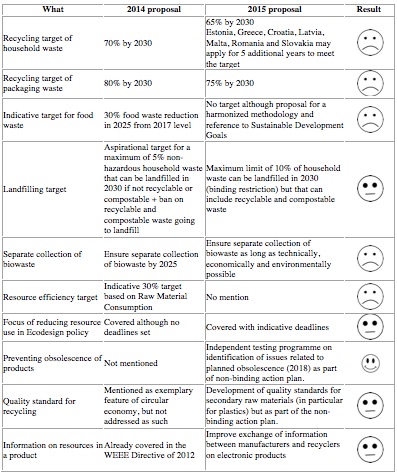A circular economy is an economic model where resources and materials are continuously re-used and recycled to reduce waste and pressure on the earth’s natural resources. Estimates from recent studies show that a circular economy could create 2 million new jobs, save European industry costs worth over €600 billion and lead to greenhouse gas emission reductions of between 2% and 4% every year [1].
In December 2015, the European Commission released a set of Circular Economy proposals aiming to make Europe more resource-efficient, but most of the legally binding targets have been watered down compared to the previous 2014 package. In short,
• Circular Economy Package could cut EU greenhouse gas emissions by 2-4% every year
• But weaker recycling targets than previous proposal will mean lower greenhouse gas emissions reductions and 110,000 fewer jobs in the UK, Germany, Poland and Italy [2]
• As the EU urged ambitious climate action at COP21, the Commission fails to walk the talk
The Circular Economy proposals include a legally binding recycling rate of 65% across the EU by 2030 and a maximum limit to the amount of household waste that can be landfilled at 10% by the same year. The package will include a new Ecodesign working plan aimed at setting product design requirements for manufacturers so that goods are made to last longer and are more repairable and recyclable.
However, the waste targets are all weaker than those proposed in the 2014 version of the package, which the Commission withdrew with the sole argument that this was necessary to deliver more ambition [3].
Here is a non-exhaustive comparison table on the major differences between the 2014 and 2015 Circular Economy Packages:
Stéphane Arditi, Policy Manager for Products and Waste at the European Environmental Bureau, commented: “The Commission has failed to deliver on its promise to come with a more ambitious proposal. The addition of some nice initiatives does not offset the fact that the legally binding core of the package, notably the waste targets, is weaker than in last year’s proposal. We’ve ended up with a wasted year and a proposal that is less ambitious.
“Lowering the recycling targets compared to last year’s proposal means that more waste will be sent to landfill or incineration plants. This is a missed opportunity because recycling creates more jobs and causes fewer emissions than either landfill or incineration.
“Europe has no choice but to become more efficient with the resources it uses. A growing global population and increased demand for the planet’s materials is forcing this. But for it to happen fast enough European Parliament and the Council of Ministers will need to inject more life into this proposal, so that the EU can lead globally in this crucial area.”
The decision to reduce the ambition for waste policy sits jarringly against a growing body of evidence showing a true, ambitious circular economy is good for both our economy and our environment. Higher targets mean benefits across the board. Reports by The Ellen MacArthur foundation, The Club of Rome and The Green Alliance all demonstrate that a radical transformation scenario is most beneficial for job creation and net cost savings [4]. The Commission’s own impact assessment states that the higher the ambition for waste management, the better it is for our economy.
Numerous regions across Europe show that it is possible to achieve high recycling rates quickly when the political will is there. In 2002, the region of Gipuzkoa was sending 80% of its waste to landfill. In 2011, the recycling rate reached 32%. In 2015, it managed to reach the EU obligation for 2020, achieving a recycling rate of 51%.
The city of Ljubljana is the first capital in Europe to declare the goal of zero waste. In 2014, it managed to collect separately 61% of its municipal waste. The city has committed to increasing separate collection rates to 78% by 2025.
[1] See European Commission Communication on Circular Economy (2014): eur-lex.europa.eu/legal-content/EN/TXT/?qid=1415352499863&uri=CELEX:52014DC0398R%2801%29.
[2] See research from Green Alliance reported in Euractiv: www.euractiv.com/sections/sustainable-dev/new-circular-economy-package-create-fewer-jobs-axed-bill-it-replaced-320018
[3] First Vice-President Frans Timmermans withdrew the package with the promise he would return with a more ambitious proposal within the year (see coverage of this by Euractiv here: www.euractiv.com/sections/sustainable-dev/circular-economy-package-be-ditched-and-re-tabled-310866)
[4] The Ellen MacArthur Foundation launches “Delivering the circular economy – a toolkit for policymakers”, www.ellenmacarthurfoundation.org/news/the-ellen-macarthur-foundation-launches-delivering-the-circular-economy-a-toolkit-for-policymakers; The Club of Rome,The Circular Economy and Benefits for Society, www.clubofrome.org/?p=8260; Green Alliance, Employment and the circular economy: job creation in a more resource efficient Britain, www.green-alliance.org.uk/employment-and-the-circular-economy.php
Adapted from European Environmental Bureau, “Smoke and mirrors as Commission issues Circular Economy Package with weaker waste targets,”(2 Dec 2015). www.eeb.org/index.cfm/news-events/news/smoke-and-mirrors-as-commission-issues-circular-economy-package-with-weaker-waste-targets/
and from:
Paul Hallows, EEB, “2015 was the year of the Circular Economy Package: what next?”, make resources count (6 Jan 2016). makeresourcescount.eu/2015-was-the-year-of-the-circular-economy-package-what-next-2/



No comments yet, add your own below